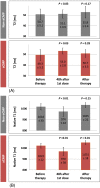Early myocardial oedema can predict subsequent cardiomyopathy in high-dose anthracycline therapy
- PMID: 36404640
- PMCID: PMC9871709
- DOI: 10.1002/ehf2.14232
Early myocardial oedema can predict subsequent cardiomyopathy in high-dose anthracycline therapy
Abstract
Aims: This study aims to assess subclinical changes in functional and morphologic myocardial MR parameters very early into a repetitive high-dose anthracycline treatment (planned cumulative dose >650 mg/m2 ), which may predict subsequent development of anthracycline-induced cardiomyopathy (aCMP).
Methods: Thirty sarcoma patients with previous exposition of 300-360 mg/m2 doxorubicin-equivalent chemotherapy who were planned for a second treatment of anthracycline-based chemotherapy (360 mg/m2 doxorubicin-equivalent) were recruited. Enrolled individuals received three CMR studies (before treatment, 48 h after first anthracycline treatment and upon completion of treatment). Native T1 mapping (MOLLI 5s(3s)3s), T2 mapping, and extracellular volume (ECV) maps were acquired in addition to a conventional CMR with SSFP-cine imaging at 1.5 T. Patients were given 0.2 mmol/kg gadoteridol for ECV quantification and LGE imaging. Blood samples for cardiac biomarkers were obtained before each scan. Development of relevant aCMP was defined as drop of left ventricular ejection fraction (LVEF) by >10% compared with baseline.
Results: Twenty-three complete datasets were available for analysis. Median treatment time was 20.7 ± 3.0 weeks. Eight patients developed aCMP with LVEF reduction >10% until end of chemotherapy. Baseline LVEF was not different between patients with and without subsequent aCMP. Patients with aCMP had decreased LV mass upon completion of therapy (99.4 ± 26.5 g vs. 90.3 ± 24.8 g; P = 0.02), whereas patients without aCMP did not show a change in LV mass (91.5 ± 20.0 g vs. 89.0 ± 23.6 g; P > 0.05). On strain analysis, GLS (-15.3 ± 1.3 vs. -13.4 ± 1.6; P = 0.02) and GCS (-16.7 ± 2.1 vs. -14.9 ± 2.6; P = 0.04) were decreased in aCMP patients upon completion of therapy, whereas non-aCMP individuals showed no change in GLS (-15.4 ± 3.3 vs. -15.4 ± 3.4; P = 0.97). When assessed 48 h after first dose of anthracyclines, patients with subsequent aCMP had significantly elevated myocardial T2 times compared with before therapy (53.0 ± 2.8 ms vs. 49.3 ± 5.2 ms, P = 0.02) than patients who did not develop aCMP (50.7 ± 5.1 ms vs. 51.1 ± 3.9 ms, P > 0.05). Native T1 times decreased at 48 h after first dose irrespective of development of subsequent aCMP (1020.2 ± 28.4 ms vs. 973.5 ± 40.3 ms). Upon completion of therapy, patients with aCMP had increased native T1 compared with baseline (1050.8 ± 17.9 ms vs. 1022.4 ± 22.0 ms; P = 0.01), whereas non-aCMP patients did not (1034.5 ± 46.6 ms vs. 1018.4 ± 29.7 ms; P = 0.15). No patient developed new myocardial scars or compact myocardial fibrosis under chemotherapy. Cardiac biomarkers were elevated independent of development of aCMP.
Conclusions: With high cumulative anthracycline doses, early increase of T2 times 48 h after first treatment with anthracyclines can predict the development of subsequent aCMP after completion of chemotherapy. Early drop of native T1 times occurs irrespective of development of aCMP in high-dose anthracycline therapy.
Keywords: MRI; anthracyclines; cardio-oncology; cardiomyopathy; cardiotoxicity; mapping.
© 2022 The Authors. ESC Heart Failure published by John Wiley & Sons Ltd on behalf of European Society of Cardiology.
Conflict of interest statement
Peter Reichardt received personal fees from Roche Holding AG and Bayer AG. Jeanette Schulz‐Menger received grants from Helios Kliniken GmbH, Siemens Healthineers, and Bayer AG. The other authors have nothing to declare.
Figures



Similar articles
-
Native myocardial T1 time can predict development of subsequent anthracycline-induced cardiomyopathy.ESC Heart Fail. 2018 Aug;5(4):620-629. doi: 10.1002/ehf2.12277. Epub 2018 Apr 19. ESC Heart Fail. 2018. PMID: 29673122 Free PMC article.
-
Ultrahigh-field cardiovascular magnetic resonance T1 and T2 mapping for the assessment of anthracycline-induced cardiotoxicity in rat models: validation against histopathologic changes.J Cardiovasc Magn Reson. 2021 Jun 17;23(1):76. doi: 10.1186/s12968-021-00767-8. J Cardiovasc Magn Reson. 2021. PMID: 34134713 Free PMC article.
-
Cardiovascular magnetic resonance characterisation of anthracycline cardiotoxicity in adults with normal left ventricular ejection fraction.Int J Cardiol. 2021 Nov 15;343:180-186. doi: 10.1016/j.ijcard.2021.08.037. Epub 2021 Aug 26. Int J Cardiol. 2021. PMID: 34454967
-
Cardiac magnetic relaxometry versus ejection fraction in anthracycline-related cardiac changes: a systematic review and meta-analysis.Open Heart. 2023 Jul;10(2):e002344. doi: 10.1136/openhrt-2023-002344. Open Heart. 2023. PMID: 37507150 Free PMC article.
-
Cardiotoxic Effect of Modern Anthracycline Dosing on Left Ventricular Ejection Fraction: A Systematic Review and Meta-Analysis of Placebo Arms From Randomized Controlled Trials.J Am Heart Assoc. 2021 Mar 16;10(6):e018802. doi: 10.1161/JAHA.120.018802. Epub 2021 Mar 4. J Am Heart Assoc. 2021. PMID: 33660514 Free PMC article.
Cited by
-
Anthracycline Cardiotoxicity in Adult Cancer Patients: JACC: CardioOncology State-of-the-Art Review.JACC CardioOncol. 2024 Sep 17;6(5):655-677. doi: 10.1016/j.jaccao.2024.07.016. eCollection 2024 Oct. JACC CardioOncol. 2024. PMID: 39479333 Free PMC article. Review.
References
-
- Nabhan C, Byrtek M, Rai A, Dawson K, Zhou X, Link BK, Friedberg JW, Zelenetz AD, Maurer MJ, Cerhan JR, Flowers CR. Disease characteristics, treatment patterns, prognosis, outcomes and lymphoma‐related mortality in elderly follicular lymphoma in the United States. Br J Haematol. 2015; 170: 85–95. - PMC - PubMed
-
- Coleman MP, Forman D, Bryant H, Butler J, Rachet B, Maringe C, Nur U, Tracey E, Coory M, Hatcher J, McGahan C, Turner D, Marrett L, Gjerstorff ML, Johannesen TB, Adolfsson J, Lambe M, Lawrence G, Meechan D, Morris EJ, Middleton R, Steward J, Richards MA, ICBP Module 1 Working Group . Cancer survival in Australia, Canada, Denmark, Norway, Sweden, and the UK, 1995‐2007 (the International Cancer Benchmarking Partnership): An analysis of population‐based cancer registry data. Lancet (London, England). 2011; 377: 127–138. - PMC - PubMed
-
- Alvarez JA, Russell RR. Cardio‐oncology: The nuclear option. Curr Cardiol Rep. 2017; 19: 31. - PubMed
-
- Swain SM, Whaley FS, Ewer MS. Congestive heart failure in patients treated with doxorubicin: A retrospective analysis of three trials. Cancer. 2003; 97: 2869–2879. - PubMed
MeSH terms
Substances
LinkOut - more resources
Full Text Sources
Medical
Miscellaneous

